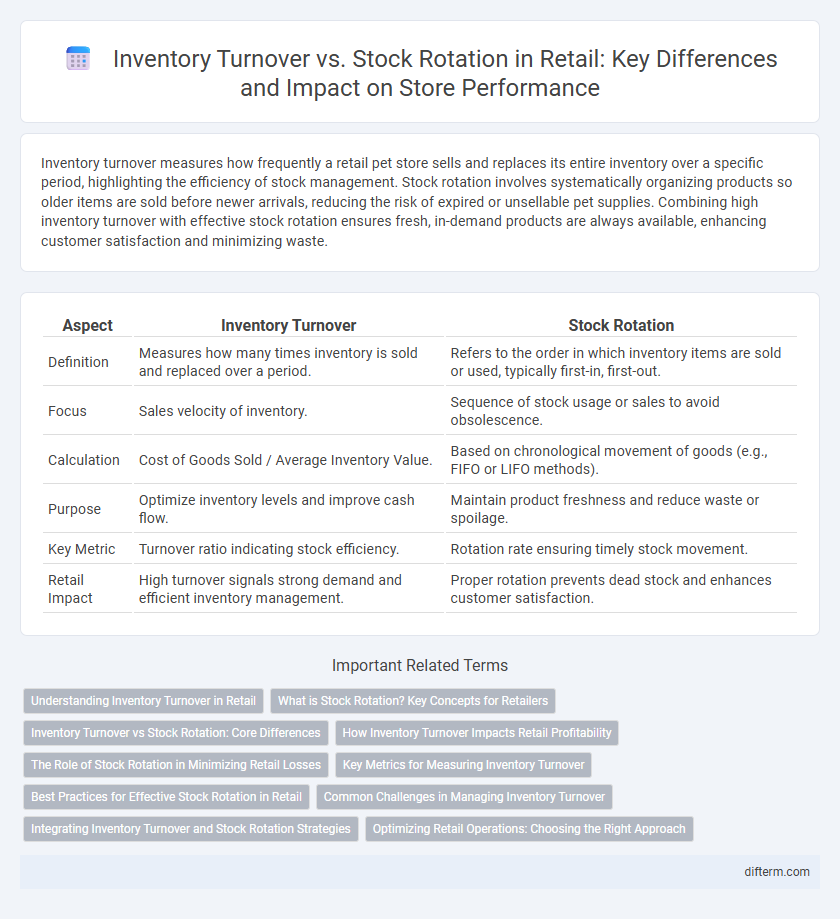Inventory turnover measures how frequently a retail pet store sells and replaces its entire inventory over a specific period, highlighting the efficiency of stock management. Stock rotation involves systematically organizing products so older items are sold before newer arrivals, reducing the risk of expired or unsellable pet supplies. Combining high inventory turnover with effective stock rotation ensures fresh, in-demand products are always available, enhancing customer satisfaction and minimizing waste.
Table of Comparison
| Aspect | Inventory Turnover | Stock Rotation |
|---|---|---|
| Definition | Measures how many times inventory is sold and replaced over a period. | Refers to the order in which inventory items are sold or used, typically first-in, first-out. |
| Focus | Sales velocity of inventory. | Sequence of stock usage or sales to avoid obsolescence. |
| Calculation | Cost of Goods Sold / Average Inventory Value. | Based on chronological movement of goods (e.g., FIFO or LIFO methods). |
| Purpose | Optimize inventory levels and improve cash flow. | Maintain product freshness and reduce waste or spoilage. |
| Key Metric | Turnover ratio indicating stock efficiency. | Rotation rate ensuring timely stock movement. |
| Retail Impact | High turnover signals strong demand and efficient inventory management. | Proper rotation prevents dead stock and enhances customer satisfaction. |
Understanding Inventory Turnover in Retail
Inventory turnover in retail measures how often stock is sold and replaced over a specific period, indicating the efficiency of inventory management. High inventory turnover rates suggest strong sales performance and effective demand forecasting, reducing holding costs and minimizing obsolete stock. Comparing inventory turnover with stock rotation highlights the frequency of product movement versus the physical rearrangement of items, both essential for optimizing retail inventory control.
What is Stock Rotation? Key Concepts for Retailers
Stock rotation is a retail inventory management technique focusing on selling older stock before newer arrivals to minimize product obsolescence and reduce waste. Key concepts for retailers include the FIFO (First In, First Out) principle, shelf life management, and regular stock audits to ensure optimum product freshness and customer satisfaction. Effective stock rotation enhances inventory turnover rates by preventing stock from remaining unsold, improving cash flow and overall merchandising efficiency.
Inventory Turnover vs Stock Rotation: Core Differences
Inventory turnover measures how many times a retailer sells and replaces its stock within a specific period, emphasizing sales velocity and financial efficiency. Stock rotation focuses on the methodical movement of inventory, ensuring older items are sold before newer ones to minimize obsolescence and wastage. The core difference lies in inventory turnover quantifying performance, while stock rotation manages product lifespan and freshness on the shelves.
How Inventory Turnover Impacts Retail Profitability
Inventory turnover measures how many times a retailer sells and replaces stock within a specific period, directly affecting cash flow and profitability by reducing holding costs and minimizing obsolescence. High inventory turnover indicates efficient stock management, leading to increased sales volume and better profit margins through optimized product availability. Retailers with slower stock rotation risk excess inventory, tying up capital and increasing markdowns, which negatively impacts overall profitability.
The Role of Stock Rotation in Minimizing Retail Losses
Effective stock rotation prioritizes selling older inventory first to minimize spoilage and obsolescence, significantly reducing retail losses. Unlike inventory turnover, which measures the frequency of inventory sales within a period, stock rotation directly manages the sequence of product sales to maintain product quality and freshness. Implementing systematic stock rotation strategies enhances shelf life management and prevents markdowns caused by expired or outdated stock.
Key Metrics for Measuring Inventory Turnover
Inventory turnover measures how many times a retailer sells and replaces stock within a specific period, highlighting efficiency in managing inventory levels. Key metrics include cost of goods sold (COGS) divided by average inventory, average days to sell inventory, and gross margin return on investment (GMROI) to assess profitability per inventory dollar. Monitoring these metrics enables retailers to optimize stock rotation, reduce holding costs, and improve cash flow.
Best Practices for Effective Stock Rotation in Retail
Effective stock rotation in retail hinges on accurate inventory turnover analysis, ensuring older stock sells before new inventory arrives to minimize obsolescence and reduce holding costs. Implementing FIFO (First-In, First-Out) methods and regular shelf audits enhances product freshness and customer satisfaction. Leveraging real-time inventory management systems enables retailers to anticipate demand patterns and optimize reorder timing for seamless stock flow.
Common Challenges in Managing Inventory Turnover
Inventory turnover quantifies how often stock is sold and replaced over a period, while stock rotation ensures older items are sold before newer ones to prevent obsolescence. Common challenges in managing inventory turnover include accurately forecasting demand to avoid overstocking or stockouts, maintaining balanced stock levels, and minimizing holding costs. Retailers often struggle with aligning turnover rates to seasonal fluctuations and changing consumer preferences, which directly impact cash flow and profitability.
Integrating Inventory Turnover and Stock Rotation Strategies
Integrating inventory turnover and stock rotation strategies enhances retail efficiency by ensuring products are sold quickly while minimizing obsolete stock. High inventory turnover rates indicate efficient sales cycles, and aligning them with strategic stock rotation optimizes shelf space and reduces waste. Retailers leveraging data-driven insights to synchronize these metrics improve cash flow and customer satisfaction through fresh stock availability.
Optimizing Retail Operations: Choosing the Right Approach
Inventory turnover measures how many times stock is sold and replaced over a period, reflecting overall sales efficiency, while stock rotation prioritizes selling older items first to minimize spoilage and obsolescence. Optimizing retail operations requires balancing both metrics to enhance cash flow and reduce waste, tailored to product type and demand variability. Retailers leveraging real-time analytics can accurately track inventory turnover and implement effective stock rotation strategies for improved profitability and customer satisfaction.
Inventory turnover vs Stock rotation Infographic

 difterm.com
difterm.com